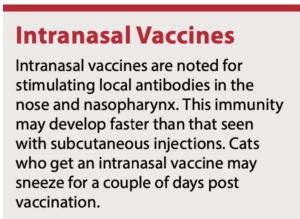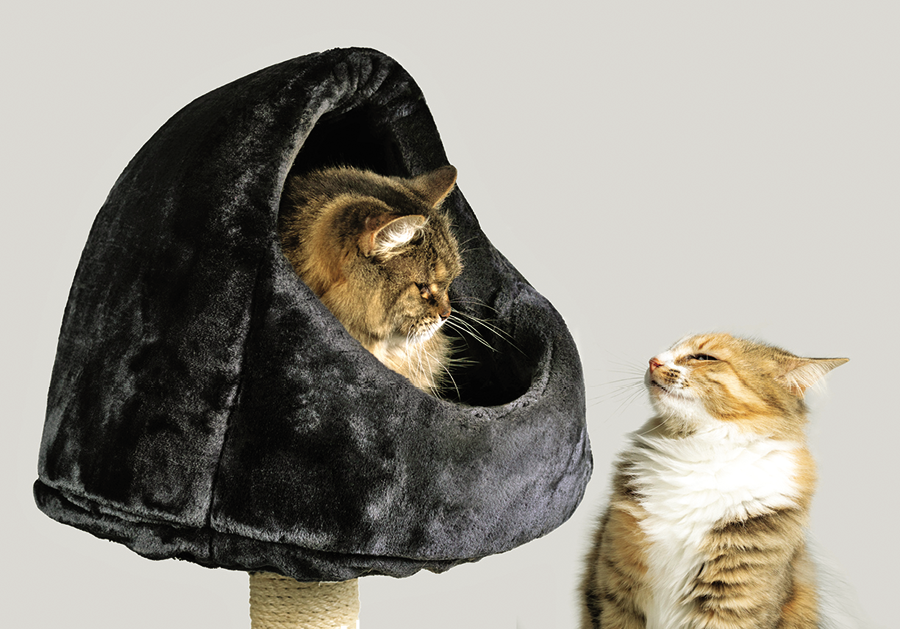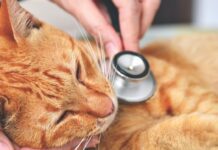For most cats, a feline calicivirus (FCV) infection is a typical upper respiratory infection. It is highly contagious and common, but FCV can progress to a serious health crisis in some cases. There is no curative treatment, but most cats will recover completely with supportive care.
Signs of FCV
Symptoms can depend somewhat upon which strain of FCV the cat contracts, but signs seen in mild cases of FCV generally include:
- Ocular (eye) discharge
- Nasal discharge
- Fever
- Lethargy
- Lack of appetite
Many cats will have some conjunctivitis (inflammation of the mucous membranes in the eye), and most will sneeze and/or cough. Cats with mild cases of FCV often recover in as little as five days, but more serious cases may take up to six weeks to fully heal.
In more severe cases, your cat may develop ulcers in the mouth, worsening the lack of appetite and causing drooling due to pain.
Pregnant cats will often have abortions. Some cats will end up with chronic gingivitis, but many cats have a full recovery.
The virus may move into the lungs and cause viral pneumonia.
In these cases, affected cats will often have an increased respiratory rate of 40 breaths per minute at rest, will be lethargic, unwilling to eat, and will often cough. (Normal respiration in a cat is under 40 breaths per minute.)
Secondary bacterial infections can develop, and hospitalization of the cat may be required.
Systemic FCV
Some unfortunate cats will experience severe systemic (body wide) calicivirus infections. This is due to a genetically different version of the virus known as (VS) FCV with VS standing for “virulently systemic.” Unlike “normal” calici infections, this version often has serious consequences.
These (VS)FCV infections usually start like normal calici infections. They tend to cause ocular and nasal discharges and, possibly, ulcers in the oral cavity. They can rapidly progress to cause high fevers, lethargy, and depression. Many affected cats develop edema (swelling) of the face and/or legs. Some will become jaundiced (exhibiting a yellowish color to the whites of the eyes, ears, and mucous membranes) due to liver involvement, and most show signs of multiple organ involvement or failure. Crusty sores may appear on the nose, ears, paws, and eyes.
While uncommon, this strain of the virus is very infectious. Researchers say there are many variants of this severe strain, all slightly different genetically. The mortality rate can approach 70% despite intensive care.
Transmission
For small groups of cats, it is not uncommon for 10% of cats to experience infections. Moving up to larger groups such as those in catteries and shelters, as many as 90% may have evidence of infection at some point. Carrier states can exist for months. In rare cases, a cat may remain a carrier for life. Female cats who are carriers can infect their kittens in utero or shortly after birth.
Most cats get calicivirus infections from other cats, most often through sneezed droplets. Unfortunately, calicivirus can survive for up to a month on surfaces such as bedding, food bowls, and litterboxes. People can act as carriers if they handle an infected cat and then an uninfected cat without taking hygiene precautions in between. Two days to two weeks after exposure, the new infections can become apparent.
 Most mild cases of FCV will not require diagnostic testing, as your veterinarian will often start symptomatic treatment for feline respiratory infections regardless of their cause. If it is important to determine exactly which upper respiratory virus is involved, or if cases progress to serious illness, then testing becomes important.
Most mild cases of FCV will not require diagnostic testing, as your veterinarian will often start symptomatic treatment for feline respiratory infections regardless of their cause. If it is important to determine exactly which upper respiratory virus is involved, or if cases progress to serious illness, then testing becomes important.
Swabs from areas of active infection or serum can be sent off for laboratory testing such as PCR or viral culture. Many cats have multiple infectious agents involved in their illness. Some veterinary clinics have rapid test kits, which can be run immediately for quick results.
FCV is a virus known for frequent mutations. Different variants of the virus tend to show propensities for certain clinical symptoms. One variant may cause a lot of lameness, whereas another may cause strictly respiratory signs.
Treatment
Treatment for a calicivirus starts out with symptomatic care. Cats with ocular and nasal discharges benefit from gentle cleaning two or three times a day. Warm compresses can help soften and loosen hard crusts. Flushing your cat’s eyes with artificial tears after cleaning can be soothing. Using a nebulizer can help. An easy way to do this is to shut your cat in the bathroom while you shower and don’t put on the fan.


Since cats rely heavily on scent for their appetite, you may need to warm up your cat’s food to create more aroma or add a “smelly” topper like the juice from a can of tuna to stimulate their desire to eat. If your cat has painful oral ulcers, she might eat better if you make her food into a slurry.
Kittens or young cats who have painful joints may need some pain or anti-inflammatory medications prescribed by your veterinarian. Do not use anything over the counter. Warm compresses on the sore areas initially may relieve some of the discomfort.
Cats who show signs of a secondary bacterial infection, including puslike discharges, should be on an antibiotic. Liquid options may be easiest to give to your cat with an upper respiratory infection. There are no anti-viral medications approved for use in cats with FCV, but nitazoxanide and 2’-C-methylcytidine (2CMC) are currently under study.
Cats who progress to pneumonia may need hospitalization. The use of an oxygen cage, intravenous (IV) or subcutaneous fluids, and a feeding tube if your cat won’t eat are all potential therapies.
Any cat with a suspected respiratory illness should be quarantined from other cats. That means a separate room with the cat’s own food and water bowls, bedding, toys, and litterbox. Ideally, you should change clothes and shoes after being in the “sickroom.” Severely affected cats may need to be in isolation for as long as three months. An important aspect of managing calicivirus infections is environmental cleaning and disinfecting after and as your cat recovers. Calici is an unenveloped virus, which means it is a tough virus to eliminate. This virus can survive for up to a month on surfaces, and potentially longer at cold temperatures. Shelter medicine veterinarians recommend accelerated hydrogen peroxide, potassium peroxymonosulfate (Trifectant, Virkon-S), and sodium hypochlorite and other products in this family (e.g., 5% bleach diluted at ½ cup per gallon) for cleaning. These products are generally effective at neutralizing FCV.
Prevention
Vaccination is the cornerstone of the prevention program for FCV, but there are some caveats. This virus mutates frequently. Even the best vaccines are not 100% effective, but they help to decrease the severity of disease in an individual cat and shorten the recovery time. Use of a bivalent vaccine (that covers two strains) is recommended, especially for cats at risk, such as those in shelters, rescues, or multi cat households with frequent turnover of residents.
The American Association of Feline Practitioners recommends vaccinating against FCV as one of the core vaccines (recommended for all cats). Kittens should receive their first vaccine at 6 to 8 weeks of age and a booster every three to four weeks until 16 to 20 weeks of age. This series should hopefully cover the kittens as their maternal immunity fades. After that, they should get a booster at 1 year of age with additional vaccinations every three years or as recommended.
Most calici vaccines are provided in a combination vaccine that contains vaccines for other feline viruses, such as feline herpes and/or feline panleukopenia. If an intranasal version is given (versus a subcutaneous injection), yearly boosters are suggested.ν
Intranasal Vaccines
Intranasal vaccines are noted for stimulating local antibodies in the nose and nasopharynx. This immunity may develop faster than that seen with subcutaneous injections. Cats who get an intranasal vaccine may sneeze for a couple of days post vaccination.
Cornell Research on FCV
John S. L. Parker, BVMS, Ph.D., a researcher at the Baker Institute for Animal Health at Cornell University, has identified a cellular receptor for FCV. The long-term goal of his work is to understand how the interactions between FCV and its receptor control infectious virus entry, viral tropism, and virulence. Knowing more about the behavior of the virus could lead to improvements in both treatment and prevention. It may also provide information on how and why the virulent form of this disease crops up. From a One Health perspective, knowledge gained about FCV may also be applicable to human calici viruses. Note: One Health is a global initiative involving physicians, veterinarians, and environmentalists working together to achieve optimal health for all living creatures.
John Parker, BVMS, Ph.D., has made progress in the fight against FCV.




